
Overuse Degrades Adirondack High Peaks Trails | Redesigning and Rebuilding Trails Can Help Solve Problem
By: Adirondack Council staff
Monday, May 20, 2019
The world-class Adirondack Park is experiencing overuse at many locations during busy weekends in the High Peaks region and across the Park.
An analysis finds unaddressed overuse is causing harm to natural resources, putting visitors at risk, and threatening the quality of the wilderness so central to the Adirondack experience.
Overuse on a trail is when the volume of and wear from use exceeds the trail’s capacity to prevent erosion, natural resource damage, and negative impacts to the user’s experience or management objectives for that location or property.
The state has recognized that the problem of overuse threatens the continued successful preservation and enjoyment of this national treasure. Some steps have been taken in response to symptoms of overuse in a couple of key locations, but no comprehensive solution has been put in place yet.
A Symptom of Under Management
Much of the negative impact of overuse and many of the trails that can’t handle current levels of use can be seen on popular hiking routes in the High Peaks region. Hiker use has soared. As measured by the New York State Department of Environmental Conservation (DEC), from 1985 to 2005, hiker registrations for the primary trail up Cascade Mountain increased 27 percent, from 6,746 to 8,601. It’s estimated that in 2010, 12,000 people hiked this peak, and in 2016, over 34,500 people climbed the same trail. Hiker registrations for the Ausable Club/Adirondack Mountain Reserve available through 2018 show use levels increased from less than 5,000 in the 1970s to over 25,000 in 2017, and slightly higher for a new record in 2018. Actual use levels across the High Peaks repeatedly reached more than 200 percent of the DEC's targeted daily capacity limits established in the 1990s.
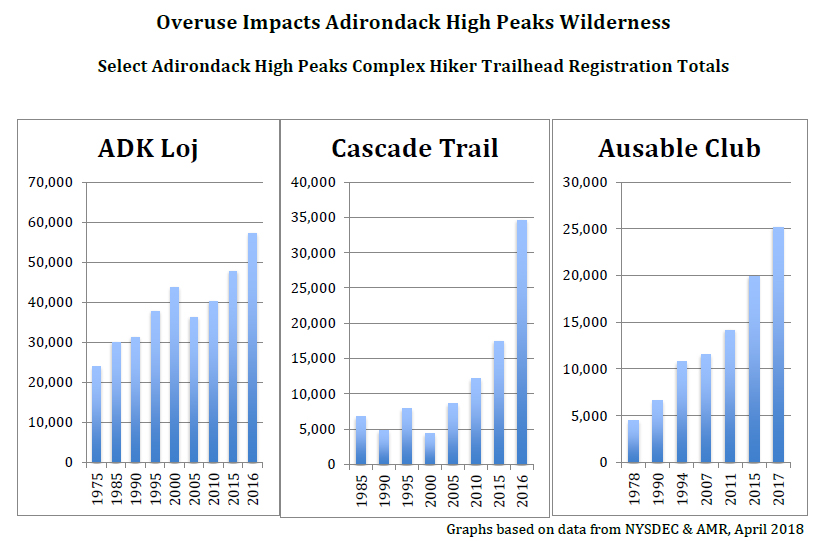
This popularity of the Adirondacks is a good thing. However, the millions of feet are negatively impacting poorly designed and under maintained hiking trails.
This damage is preventable. We can preserve the Adirondacks and enjoy it too.
National experts and the DEC have said “Six BMPs (Best Management Practices) are essential for Wildlands Management” and to address overuse. These six elements of a successful comprehensive solution are: 1) improved planning, 2) expanded education and outreach (including teaching of Leave No Trace outdoor skills and ethics), 3 & 4) front and backcountry infrastructure; 5) limits on use at some times in some locations, and; 6) additional staffing and funding. Without all six practices, visitors, nature and wilderness will suffer. With all six essentials, the DEC and Adirondack communities can welcome more visitors and preserve the legacy of Adirondack wilderness for current and future generations.
Partnering with various stakeholders and local governments, the state is expanding efforts at education and outreach, starting to test systems that limit and redirect peak use, and beginning to improve infrastructure.
The analysis below demonstrates that the Adirondacks have the people and the knowledge needed for another element of a comprehensive solution, a redesigned and rebuilt sustainable trail system that provides the world-class backcountry infrastructure the Park needs.
Looking Back to Look Ahead
Adirondack Council Executive Director Willie Janeway was Director of the Adirondack Mountain Club (ADK) trails program from the mid-1980s to the mid-1990s. He taught trails skills across the country for the Student Conservation Association (SCA), and previously worked on and lead the Appalachian Mountain Club professional trail crews in New Hampshire. During his tenure at ADK, trail crews fielded in partnership with the state DEC intensively reconstructed trails using native rock in remote Adirondack wilderness.
In 2018, Willie returned to many of the same trails with Nancie Battaglia to document the same locations to see how the trails have fared.
Many of the old famous “Adirondack mud holes” that Janeway would urge hikers to go through rather than around to avoid making the situation worse have been improved through a combination of drainage, trail hardening, relocations, and hiker education.
Trails that saw more use, but had not been redesigned or rebuilt, were worse. Where trails had been reconstructed but not maintained, or where trails had been rebuilt to handle a level of use that has been far exceeded, problems returned and are sometimes getting worse. Important victories were apparent too. Some trails had been rebuilt and stabilized. Additional negative natural resource impacts were halted and, in some cases, even reversed.
This analysis supports the conclusion that redesigning and rebuilding trails should be one part of a comprehensive solution to overuse impacts. Successful trail work, combined with new “sustainable trail” standards and techniques mastered by 21st Century Adirondack trails professionals, suggest a critical part of the solution to overuse is possible if funding is provided to redesign and rebuild Adirondack trails. Individuals, organizations, agencies, and private businesses are poised to scale up to address the problem if the resources are made available.
Overuse is Causing Poorly Built Trails to Get Worse
The first of two photos below show Willie measuring the loss of more than 2 ½ feet of soil because of hiker traffic without erosion controls in place. The second shows an increase in trail width and increased erosion and natural resource damage. Both sites, like others on Cascade, continued to get worse in 2017 and 2018.
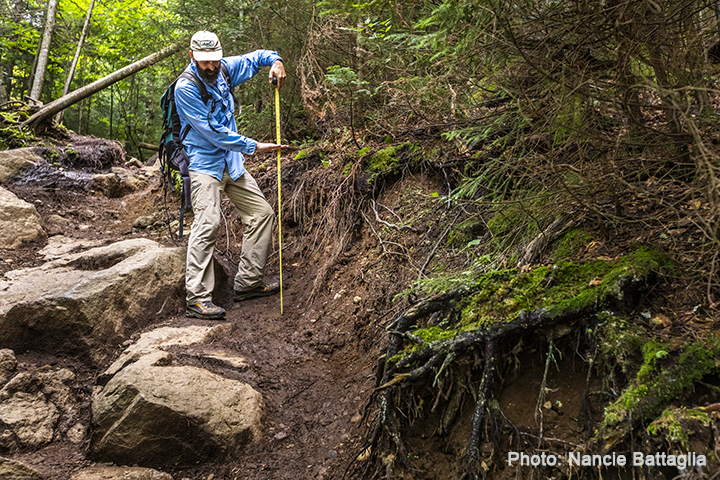 Willie measuring the loss of more than 2 ½ feet of soil because of hiker
Willie measuring the loss of more than 2 ½ feet of soil because of hiker
traffic without erosion controls in place
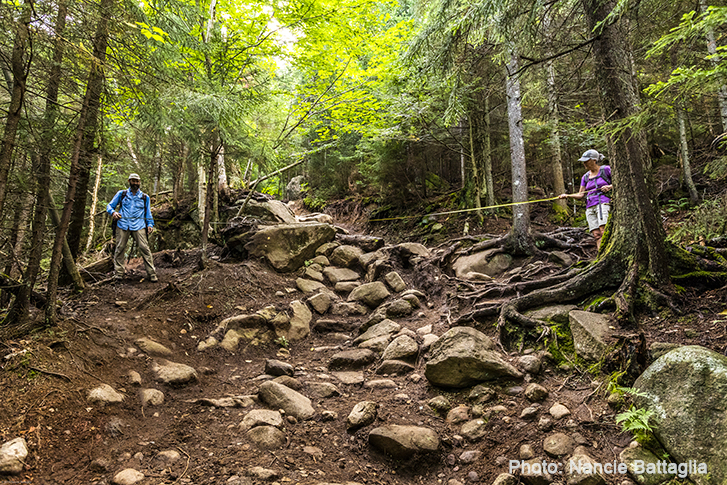 An increase in trail width and increased erosion and natural resource damage
An increase in trail width and increased erosion and natural resource damage
The comparison slider below shows a trail in the Adirondack High Peaks Wilderness in the 1980s versus the same trail in 2018. At this location, this trail has roughly tripled in width in less than 30 years, to over 25 feet. it would be worse without the trail work that was done by the Adirondack Mountain Club (ADK). Without a sustainable trail design and adequate reconstruction and maintenance, high use caused soil loss and compaction, damage to natural vegetation, and erosion. This highlights that in some cases the legacy of poor trail design can contribute as much or more to natural resource damage as high use.
Note: Please click and hold the center bar while sliding left and right to view the before and after photos.
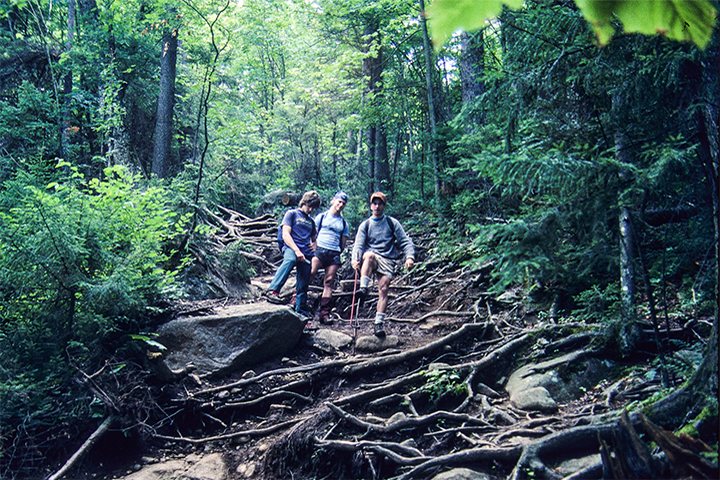
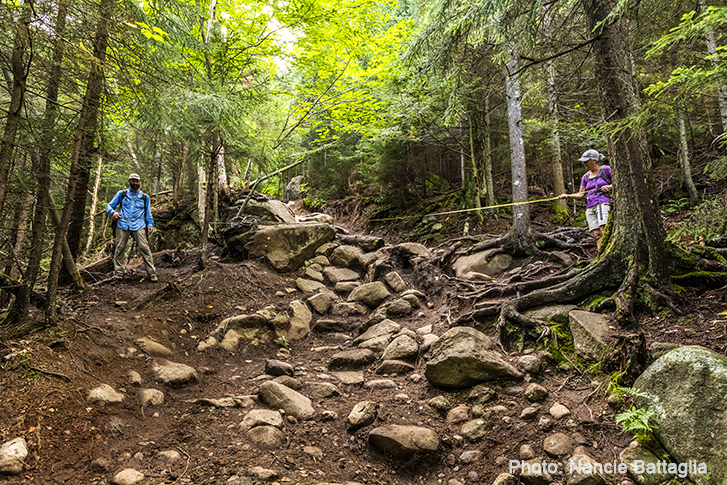
in the 1980s. The photo on the right shows the same trail in 2018, more than
triple in width to over 25 feet.
An analysis in 2018 by Adirondack Park trail professionals found over 130 miles of trails in the High Peaks region “in need of significant redesign, reconstruction and/or repair.” The report said “…all trails need annual maintenance. These trails need much more than maintenance – not for user convenience – but to correct and prevent further damage to the Park’s forests, pure waters, wildlife and wild character.” Last year, after a massive effort, a new two-mile sustainable trail up Mt. Van Hoevenberg was opened, albeit half-finished. At this pace, it could take 130 years to fix the problem.
Trails are Getting Better When Redesigned and Rebuilt
This comparison slider below shows before and after photos of a trail that has been improved and stabilized with the construction of rock trail. Drainage and planting restored the damaged environment on the left and right, and the trail is now narrower.
Note: Please click and hold the center bar while sliding left and right to view the before and after photos.
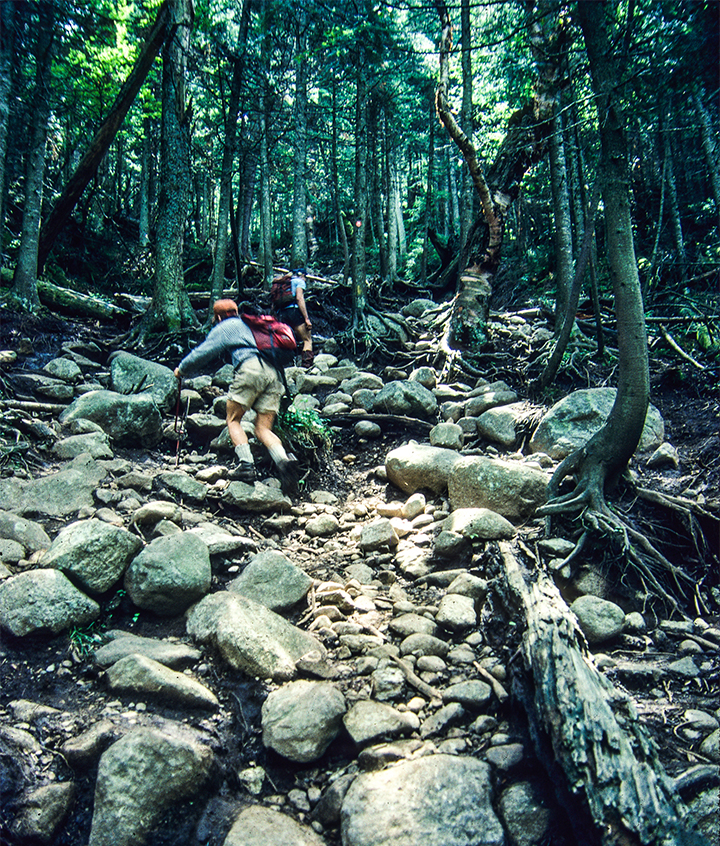
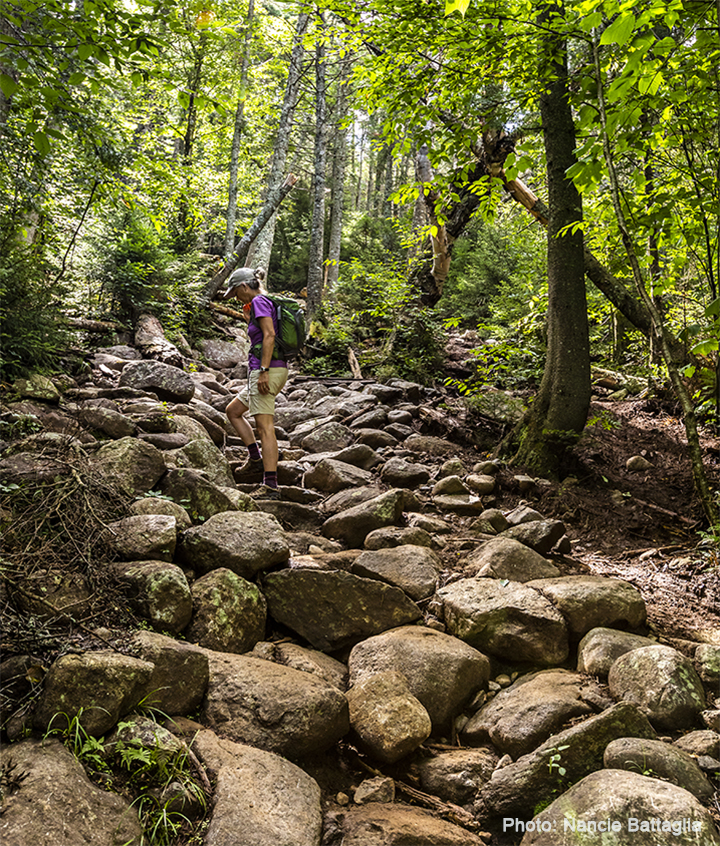
with the construction of rock trail, drainage and planting to restore damaged areas.
There are ongoing trail efforts by dedicated professionals and volunteers, but trail damage is widespread, and restoration is a massive undertaking
Problems When Trails are Improved, but not Maintained
Below in the comparison slider, the photo on the left shows a trail before it was reconstructed, and before a tree blew down across its path. The photo on the right shows that when the fallen tree isn’t removed from the trail and blocks the carefully built rock staircase, foot traffic is detoured to the left, off the hardened surface. Again, more natural resource damage occurs just because the fallen tree was not cleared. The before photo also shows ADK trails professional Doug Halporn using a surveyor’s wheel, which measures trail length. It was used as part of a region-wide assessment and prioritization of trail conditions in the 1980s.
Note: Please click and hold the center bar while sliding left and right to view the before and after photos.
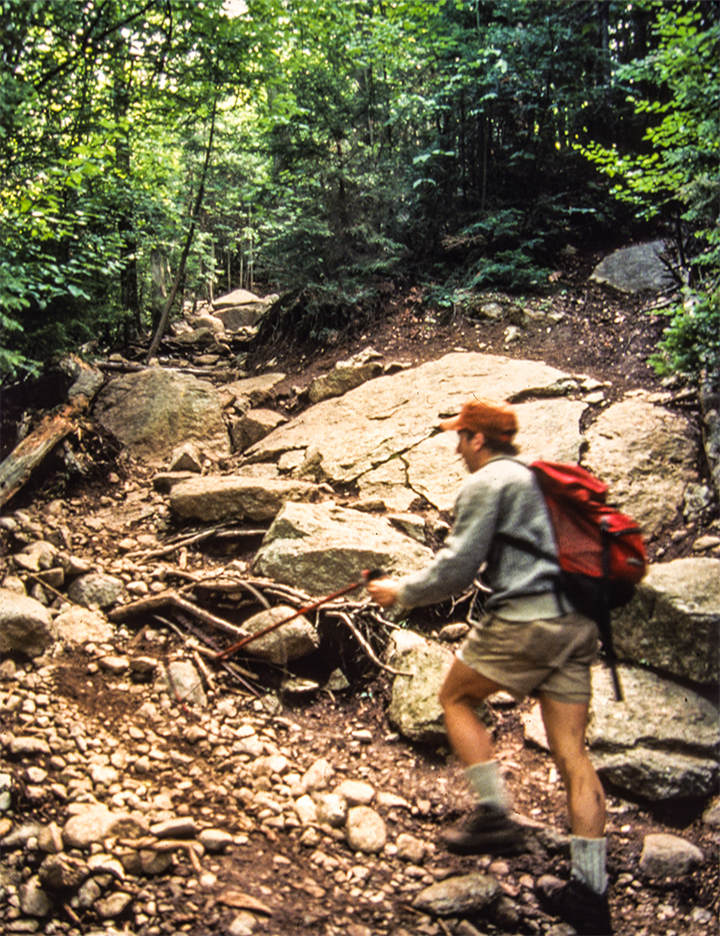
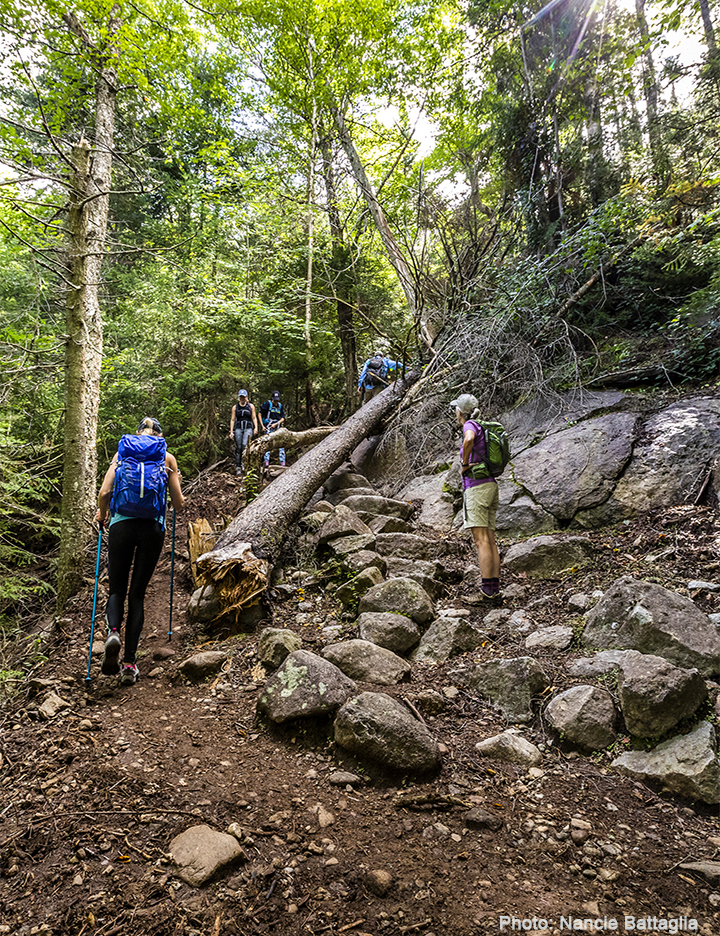
shows the tree remaining, causing the trail to be widened, causing more natural
resource damage.
The comparison slider below shows how simple maintenance, like cutting a path through the downed tree, reestablished the trail on the hardened rock route, and allowed vegetation to regenerate in the area. The photo on the left shows the trail with the downed tree intact on the trail, and the photo on the right shows the trail with the tree with a path cut through it. The redesign, reconstruction, and annual maintenance of trails is important to keep them open, safe and long-lasting.
Note: Please click and hold the center bar while sliding left and right to view the befoe and after photos.
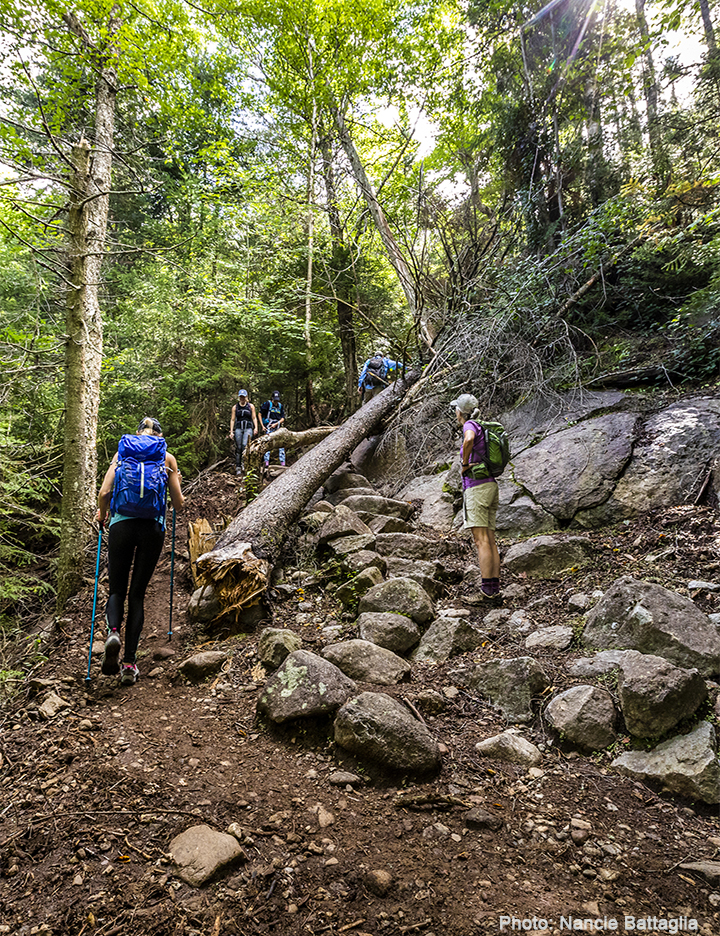
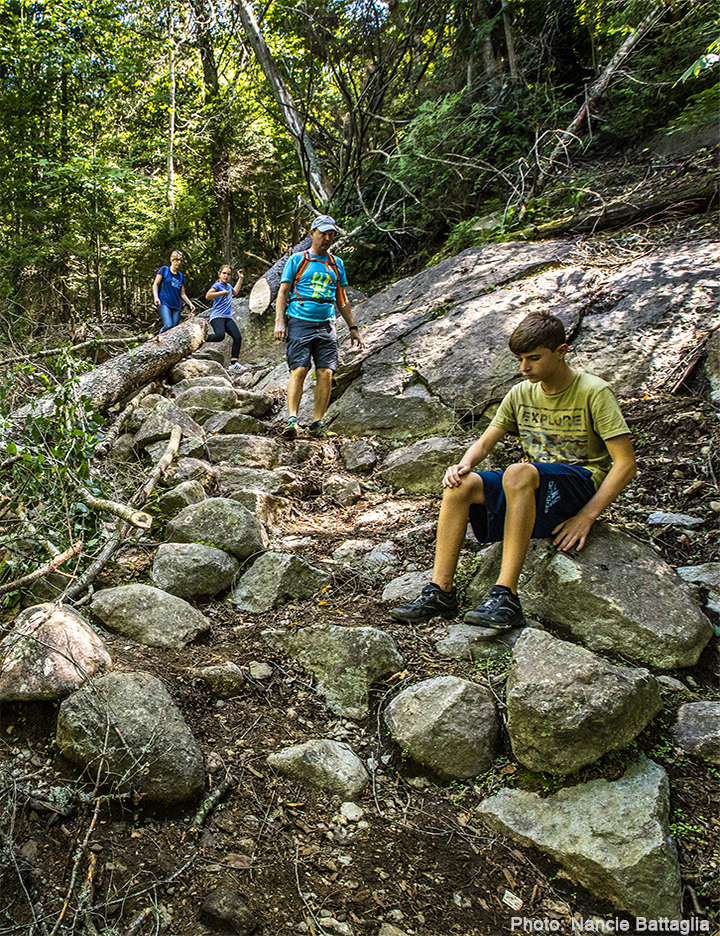
The photo on the left shows the trail with the downed tree on the trail, and the photo on
the right shows the trail with the tree with a path through it.
Trail Improvement Protects Natural Resources
Trail improvements, properly maintained, protect natural resources. In the comparison slider below, the photo on the left shows a rebuilt section of trail on Blue Mountain that included a rock tread and small balsam trees transplanted to renovate eroded areas on the side. The photo on the right is from 2018, which shows those small trees had grown to over 30 feet, and the trail continued as a success story. That work was done by professionals and volunteers jointly sponsored by the Adirondack Mountain Club, the DEC and the Town of Indian Lake.
Note: Please click and hold the center bar while sliding left and right to view the befoe and after photos.
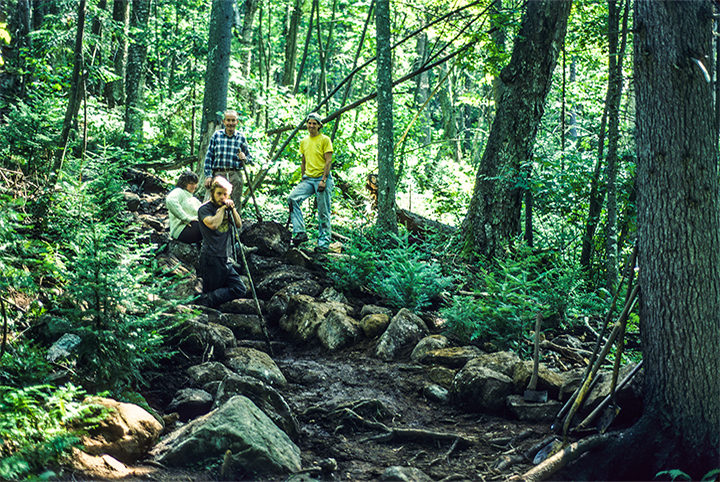
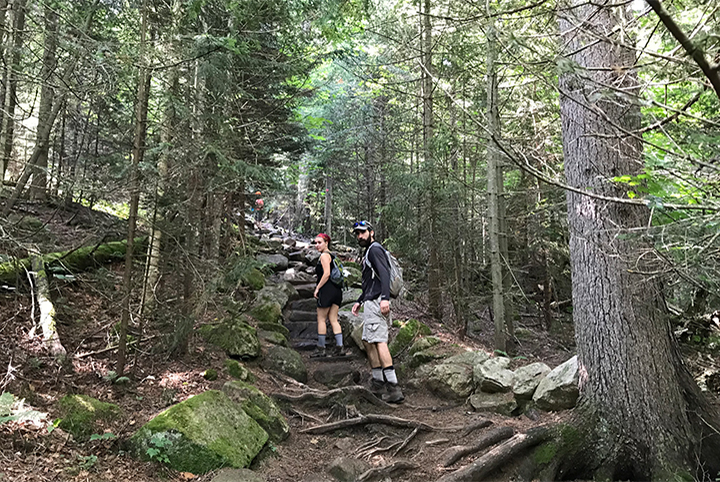
planting small balsam trees to renovate eroded areas. The photo on the
right is from 2018, which shows those trees had grown to over 30 feet.
Looking Ahead
These photos offer examples of overuse that is and isn’t being addressed and the negative impacts from overuse on the Adirondack Forest Preserve.
One place that damage to the natural resources and wilderness can be measured is on the Wilderness trails in and near the High Peaks region. The photo comparisons from the 1980s and 2018 show that heavily used, unmaintained and unsustainable trails get worse over time with erosion and damage to natural resources.
These photos also represent what is evident across the Adirondack trail system, and what is known by trail professionals across the country. Trail erosion and natural resource damage can be prevented with sustainable trail redesign, reconstruction and maintenance.
Note: Please click and hold the center bar while sliding left and right to view the before and after photos.
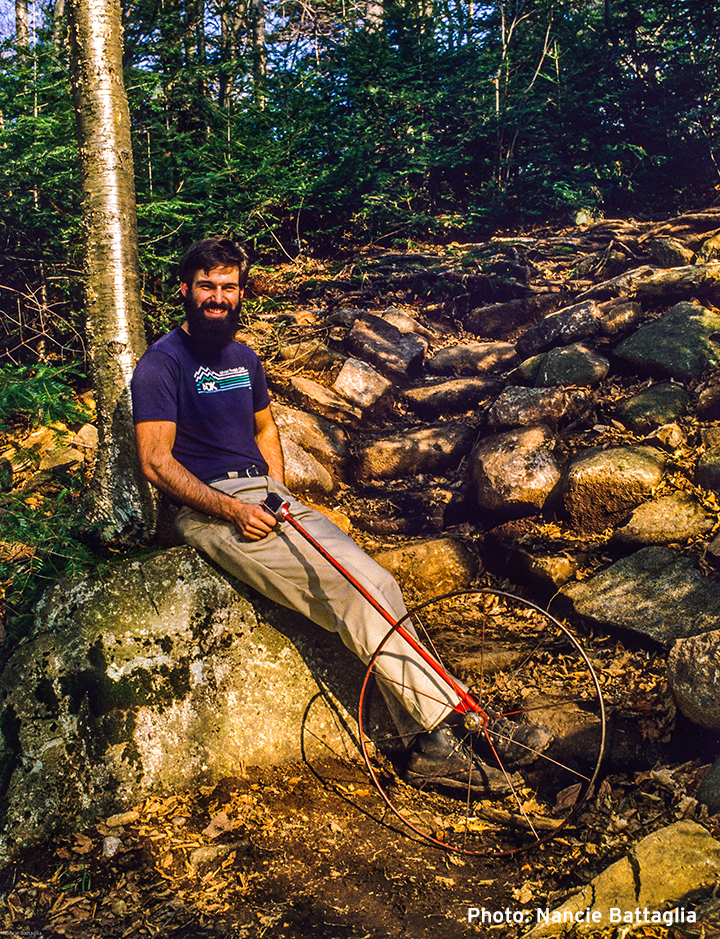
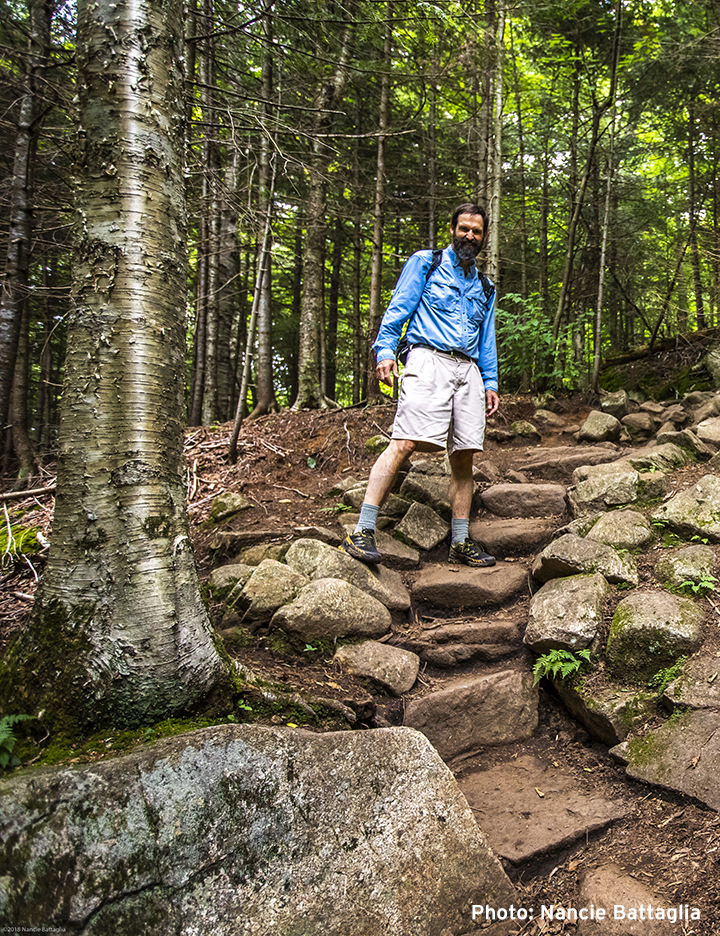
Willie Janeway on the Cascade Trail in 1989 and by the same successful rock staircase in 2018, showing how trail work, done right, can be one part of decreasing the impact of overuse.




